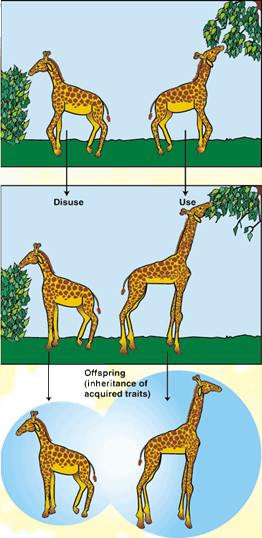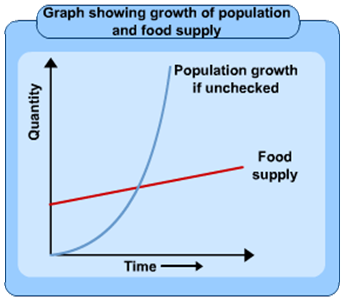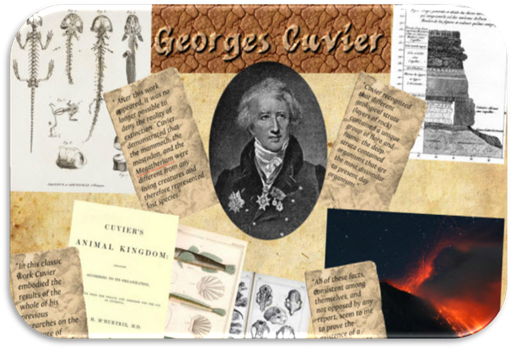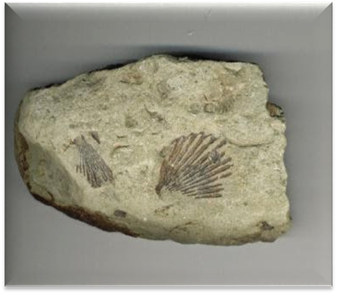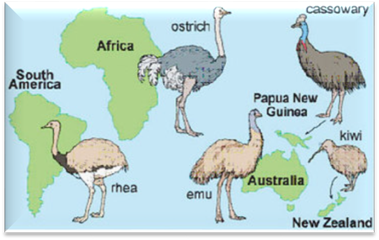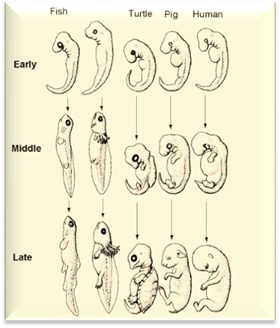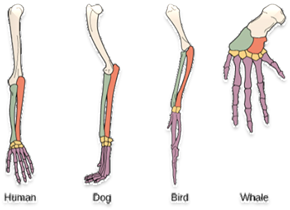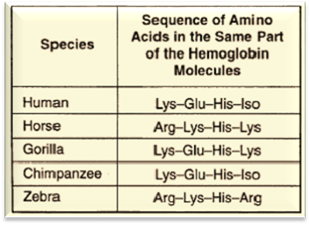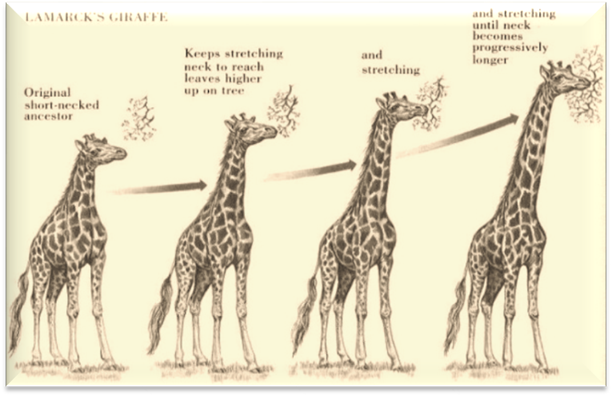
EVOLUTION
Evolution is the
process by which species may change over a long period of time. Throughout
history, scientists have known that living things evolve to survive. However,
it wasn’t completely understood how the process of evolution occurs, as there
was no clear evidence and no strong theory to explain evolution. Charles Darwin
eventually figured out an explanation of how living things evolve and he
provided evidence for his new idea of evolution. Darwin was not the first to
come up with the idea that evolution happens, but he was the first to provide
evidence to support the idea convincingly.
Charles
Darwin
Charles Darwin was an English naturalist as he studied
nature and the diversity of life within it. In 1859, Charles Darwin announced
his theory of evolution called Natural
Selection. Darwin’s theory of natural
selection which explains the evolution of living organisms, required
evidence and a thorough and complete explanation of how and why organisms
change over time.
In 1831, Darwin traveled, for approximately 5 years,
aboard a ship called the HMS Beagle.
The Beagle made the voyage from
Europe, through the Atlantic Ocean, around South America, across the Pacific
Ocean, along Australia, and back to Europe around Africa. While going around
South America, Darwin collected fossils of extinct armadillos. The fossils were
similar, but not identical to the living armadillos of that area. On the west
side of South America, the Beagle made a stop at the Galapagos Islands. These
islands greatly helped Darwin in his development of the theory of natural selection.
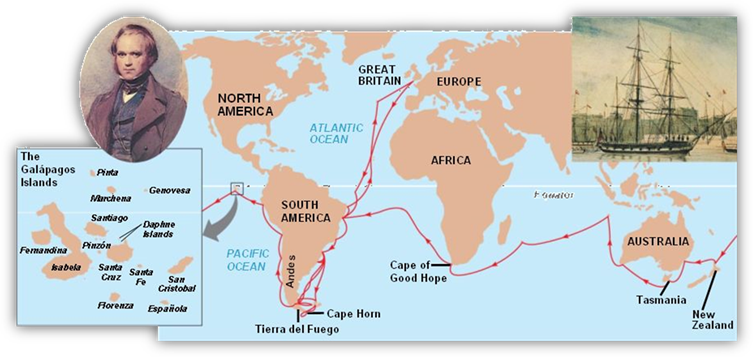
Darwin collected many different types of finches
(birds). All of the finches he collected were very similar, but there were
distinct differences in the birds’ beak size and shape. The beaks were adapted
to that particular finch’s type of food. Furthermore, Darwin noticed that many
of the organisms on the islands were similar but not identical to the organisms
he found in South 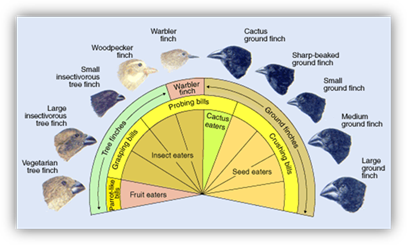 America. Upon that discovery, Darwin
stated that the Galapagos Island organisms had descended from organisms that
came from South America. As with the finches Darwin collected, he suggested
that all of the finches on the islands descended from one finch species that
migrated from South America. Then, with time, the finch species’ beaks began to
modify based on their food source. Darwin called this process “Descent with Modification”.
America. Upon that discovery, Darwin
stated that the Galapagos Island organisms had descended from organisms that
came from South America. As with the finches Darwin collected, he suggested
that all of the finches on the islands descended from one finch species that
migrated from South America. Then, with time, the finch species’ beaks began to
modify based on their food source. Darwin called this process “Descent with Modification”.
Darwin also studied the popular practice, in Europe,
of breeding exotic pigeons. He also began to study the breeding of other plants
and animals. Within these studies, breeders take advantage of variations in
traits to obtain offspring with the desired traits. Darwin realized through
this type of breeding, called artificial
selection, traits can be inherited. (Remember, this is the mid-1800s and
Gregor Mendel’s work with pea plants and heredity was not discovered yet.) Artificial selection is the selection of traits for offspring performed by humans
not nature.
After returning from his voyage, Darwin spent years
studying his data and formulating his explanation. He did not report his ideas
about evolution until a time much later in his life. He struggled with his
ideas of evolution, because of public opinion and how controversial his new
idea would be to society. In Darwin’s time, many people did not believe that
organisms changed over time. Public opinion was solely based on biblical
beliefs. They believed living things were, at that time, the same as they
always were, and Earth was the same as it always was and that both never
changed. For Darwin to come forth with his theory of evolution would go
straight against public belief, which may have possibly destroyed his
professional life and lead to a life of continuous public criticism.
|
Contributions
to Darwin’s Theory |
|
|
Lamarck In
1809, Jean Baptiste Lamarck developed an explanation for evolution. Lamarck
shared many of the same ideas as Charles Darwin, such as organisms are well
adapted to their environment, and that organisms change over time as they
adapt to changing environments. One other idea that Lamarck believed that
Darwin initially accepted was that the use or disuse of a trait would be
passed to offspring. For example, Lamarck believed that giraffes kept
stretching their necks higher and higher to eat leaves high up in the tree.
As the giraffes continued to stretch their neck, generation after generation,
that the offspring of each generation continued to inherit longer and longer
necks. Keep in mind that Lamarck also stated that the disuse of a trait would
have it shrink away, generation after generation. This concept of Lamarck’s
theory of evolution was disproved and later rejected by Darwin. |
|
|
|
Malthus In
1838, Thomas Malthus, an economist, helped Darwin form his theory of natural
selection. In 1798, Malthus made a connection between the food supply and the
human population. He observed the food supply increasing linearly, as more
food was being produced each year, and the human population growing
exponentially. Malthus concluded that not all humans can survive in this way,
because many humans would die from food shortage, war, and disease. Darwin
applied this idea to his theory. Darwin stated that organisms tend to produce
more offspring than can survive and that the environment limits the species
types in a population. This is the basis of his theory of natural selection. |
|
Cuvier, Hutton, and Lyell Georges
Cuvier was a paleontologist that helped Darwin by explaining how the deeper a
fossil remain was found in rock strata (layers), the more different it was
from the similar species living in the present. James Hutton and Charles
Lyell were geologists that developed the idea of uniformitarianism. Uniformitarianism basically states
that current geologic processes occur at the same gradual rate and in the
same gradual manner as geologic processes of the past. Darwin used this idea
to help explain the changes in species over time, saying that these species’
changes took place gradually over long periods of time from generation to
generation. [It should be noted that the opposite
of uniformitarianism is catastrophism. Catastrophism is the theory that
sudden, quick, and violent events occurred in Earth’s past, changing Earth’s
crust. Catastrophism has been proven with events such as large volcanic
eruptions which result in quick, sudden changes to Earth’s geology.] |
|
Natural Selection
Charles Darwin used all that he learned from his
voyage on the Beagle and from all of the scientists before him to develop his
theory of evolution known as Natural
Selection. In 1859, Darwin published a book of his theory explanation and
evidences entitled On the Origin of Species by Means of Natural Selection.
Natural Selection focuses on one key
idea that all offspring have the potential to survive and reproduce, but not
all will survive and reproduce because of their environment. The emphasis is on
being able to survive and reproduce.
The need to evolve arises from the environment
presenting challenges that the species needs to overcome in order to survive
and reproduce, such as a body of water formation, sunlight disappearance, or
interaction changes. For example, if sunlight exposure on plants is suddenly
limited, over time, only plants which require little light exposure will
survive and reproduce.
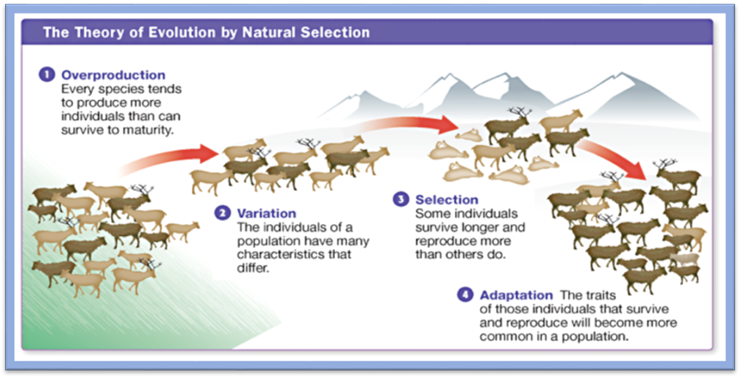
The four overall steps of Natural Selection are as follows.
1. Overproduction:
Every population is capable of producing more offspring than can possibly
survive. When we use the term survive with Natural Selection, it refers to the
ability to survive to maturity and have the ability to reproduce.
2. Variation:
Within every offspring population there are many offspring of great diversity
in the form of inherited traits.
3. Selection:
The environment, or nature, chooses which offspring will survive and reproduce.
Certain characteristics of the environment require certain characteristics of the
organisms in order for the organisms to survive and reproduce. With all of the
different types of offspring from step 2, some will have the necessary traits
to survive in a particular environment and some will not have the necessary
traits to survive and reproduce.
4. Adaptation:
Over long periods of time and several generations those traits that allowed a
species to survive and reproduce will become more and more common within the
population. Adaptation does not occur within a single organism, it occurs within
a species or population.
The important ideas to remember about natural
selection as a theory of evolution is that it is a slow gradual process, it
occurs in species or populations and not individuals, and the goal of it is to
survive and reproduce.
|
Darwin’s Evidence |
|
|
Fossil Record |
|
|
A
fossil is a trace of an organism that lived in the past. Comparing fossils
and living organisms may present a pattern of gradual change within a species
over a long period of time. |
|
|
Biogeography |
|
|
Biogeography
is the study of the locations of organisms around the
world. Sometimes, separated landmasses were once connected together.
While connected together, one particular species may have lived on that
landmass. When the landmass separates, the one original species then needs to
evolve and adapt to the new conditions on each of the new landmasses.
Examining the movement of landmasses can help explain similarities in living
organisms and fossils. |
|
|
Developmental Biology |
|
|
Embryology
is the study of development by way of embryo formation and development.
Completing comparison studies of embryos can identify similar patterns and
structures which can be used to show relationships among different species
that may have evolved from one common ancestor. |
|
|
Anatomy |
|
|
Anatomy
is the study of bodily structure. Identifying similar bodily structures
(homologous structures) among different species may help to discover a common
ancestor of the different species in question. |
|
|
Biochemistry |
|
|
Biochemistry
refers to the chemistry of a living organism, as in nucleotide sequences or
amino acid sequences. Identifying similarities in the specific biochemistry
of a group of organisms, may show a relationship among the organisms in
question. |
|
Microevolution and Macroevolution
The basis of Charles Darwin’s theory of natural
selection has withstood the test of time, however, it was missing one essential
element. Darwin’s theory did not discuss the genetics of evolution, because it
was not known of at the time of his theory development. When Gregor Mendel’s
laws of heredity were made known, this allowed new studies into Darwin’s theory
in the attempt to update it. The updated version of natural selection, by
primarily adding genetics, is called the Modern
Synthesis of Evolutionary Theory.
Evolution can be studied between two scales:
microevolution and macroevolution. The link between the two scales is
speciation.
|
Speciation |
|
|
Speciation
is the formation of new species and is the link between microevolution and
macroevolution. Speciation can be seen as a process of genetic change or as a
pattern of change in the form of organisms. |
|
|
Microevolution |
|
|
Microevolution
focuses on how inherited traits change over time in a population, focusing on
the kinds of genes that will exists in a population over several generations. |
|
|
Natural
Selection |
As
you have already learned throughout this unit, can cause an increase or
decrease in a particular allele in a population. |
|
Migration |
The
movement of individuals into, out of, or between populations. Migration can change
the number and types of alleles in a population. |
|
Mate
Choice |
If
mating is random, there will be great variation is the alleles of the
offspring. If mating is limited or selective, then there will be a limited
set of alleles in the offspring. |
|
Mutation |
Mutations
are rare, but can cause a change in the number and type of alleles from one
generation to the next. |
|
Genetic
Drift |
|
|
Macroevolution |
|
|
Macroevolution
focuses on how new species evolve, in terms of direction, diversity, or speed
of change. |
|
|
Convergent
Evolution |
|
|
Coevolution |
Two
species, living in close association or interaction, evolve together or one
species evolves as a result of their counterpart evolving. |
|
Adaptive
Radiation |
One species splits into two or more
species which then can result in those new species splitting further. A
line of descendants is called a lineage. |
|
Extinction |
All
of the members of a lineage die off. The particular species is gone from
existence forever. |
|
Gradualism |
Small gradual changes in species that
occur over a long period of time. |
|
Punctuated
Equilibrium |
Quick and sudden evolution of a species
after a long period of species stability, when there was never a need to
evolve. Some environmental change occurred, creating a new
pressure for the species and forcing the species to quickly evolve. |
UNIT VOCABULARY
REVIEW
